Browse Our Encyclopedia Of Monsters & Cryptids
Our exclusive collection includes many well-known cryptids as well as creations from guest artists and the imaginations of the creature-curious worldwide! Browse our monster encyclopedia to learn, explore, and get inspired by a world of wonder and adventure.
Search Our Cryptid Collection...
Or Browse Monsters Alphabetically
Bigfoot
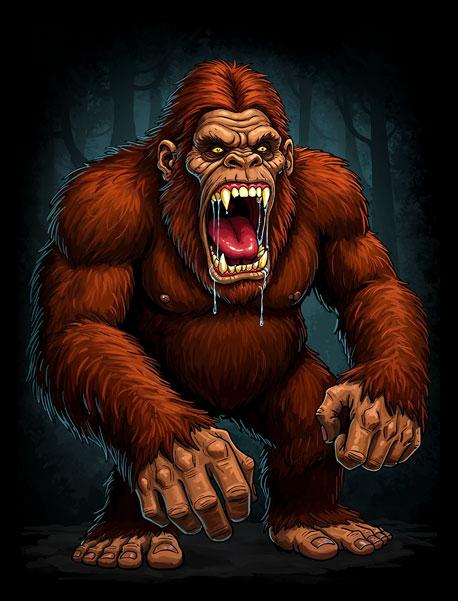
Bigfoot
Type: Cryptid / Hominid
Region: North America
Description: Bigfoot, also known as Sasquatch, is a large, ape-like creature said to inhabit remote forests across North America. Descriptions typically include a height of 7–10 feet, a muscular build, and thick, dark reddish-brown hair covering the body. It walks upright and is known for leaving oversized footprints—some over 15 inches long.
Behavior: Shy and elusive, Bigfoot is often associated with wood knocking, strange vocalizations, and foul odors. Despite numerous sightings, no definitive scientific evidence has confirmed its existence.
Cultural Significance: Rooted in Indigenous folklore and amplified by modern sightings, Bigfoot has become an enduring symbol of wilderness mystery and a staple of cryptozoological lore.
Chupacabra
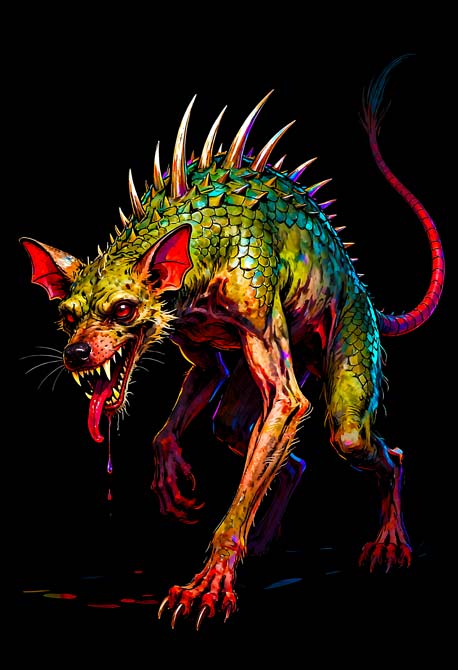
Chupacabra
Type: Cryptid / Quadruped
Region: The Americas (Primarily Puerto Rico, Mexico, Southern United States)
Description: The Chupacabra — whose name translates to “goat-sucker” in Spanish — is a vampiric creature infamous for attacking livestock, especially goats, and draining them of blood. Descriptions vary widely: early accounts from Puerto Rico in the mid-1990s describe a reptilian, bipedal creature standing 3–4 feet tall, with gray-green scaly skin, sharp quills or spines along its back, and large red eyes that glow in the dark. Later sightings across Mexico and the American Southwest depict a more canine form — a hairless, mangy beast with fanged jaws, leathery skin, and an unnatural gait. Despite the conflicting imagery, all share a single hallmark: a thirst for blood.
Behavior: The Chupacabra is nocturnal and elusive, striking under cover of darkness. It leaves behind victims drained of blood through small puncture wounds, often with no signs of struggle. Some witnesses claim it moves in short, hopping bursts like a kangaroo; others say it stalks like a coyote or prowls on all fours. Sightings often follow reports of mutilated livestock, strange tracks, or eerie screeching cries echoing through rural farmland. Its intelligence and cunning have led some to speculate it may not be of earthly origin.
Cultural Significance: Since its first reported attacks in Puerto Rico in 1995, the Chupacabra has become one of the most recognizable modern cryptids — a symbol of rural fear, media frenzy, and the blurred line between folklore and fact. Its legend spread rapidly across Latin America and into the United States, inspiring documentaries, horror films, and countless local tales. Whether viewed as a cryptid predator, a government experiment gone wrong, or an alien interloper, the Chupacabra remains a chilling emblem of mystery and modern myth.
Dogman

Dogman
Type: Cryptid / Bipedal Canine Entity
Region: North America (notably Michigan, Wisconsin, Kentucky, Alabama, and rural forests across the U.S.)
Description: The Dogman is a fearsome cryptid known for its wolf-like head, upright stance, and terrifying presence. Frequently mistaken for werewolves, Dogmen differ by being described as natural creatures, not cursed humans. With a towering, upright frame and the intelligence of a predator, the Dogman is often spotted lurking near roadsides, forests, or even farmhouses—then disappearing without a trace. Accounts often mention deep growls, a foul odor, and intense eye shine, usually yellow, amber, or red. Though sightings stretch across North America, local legends give the Dogman regional variations, each with unique temperaments—from silent watchers to aggressive, territorial beasts.
Behavior: Dogmen are typically described as nocturnal, elusive, and deeply territorial. Witnesses report being stalked, watched, or even charged by the creature—only for it to retreat just before direct confrontation. The Dogman’s uncanny intelligence and eerily humanoid posture contribute to its frightening mystique. Unlike Bigfoot, it is rarely associated with peaceful or passive behavior.
Cultural Significance: Many Native American stories speak of spiritual canid beings, protectors of forests or omens of imbalance. The modern Dogman legend surged in popularity after the “Michigan Dogman” song aired on local radio in 1987—ironically meant as a hoax—only to spark a flood of real encounters. While in Alabama folklore circles, some believe the Dogman may be linked to cursed Civil War-era burial sites or remnants of ancient Native legends, making it not just a creature of flesh—but possibly one of spirit or curse. The Dogman has gained a foothold in American cryptid lore, with countless reported sightings, podcasts, books, and documentaries dedicated to its legend.
Dover Demon
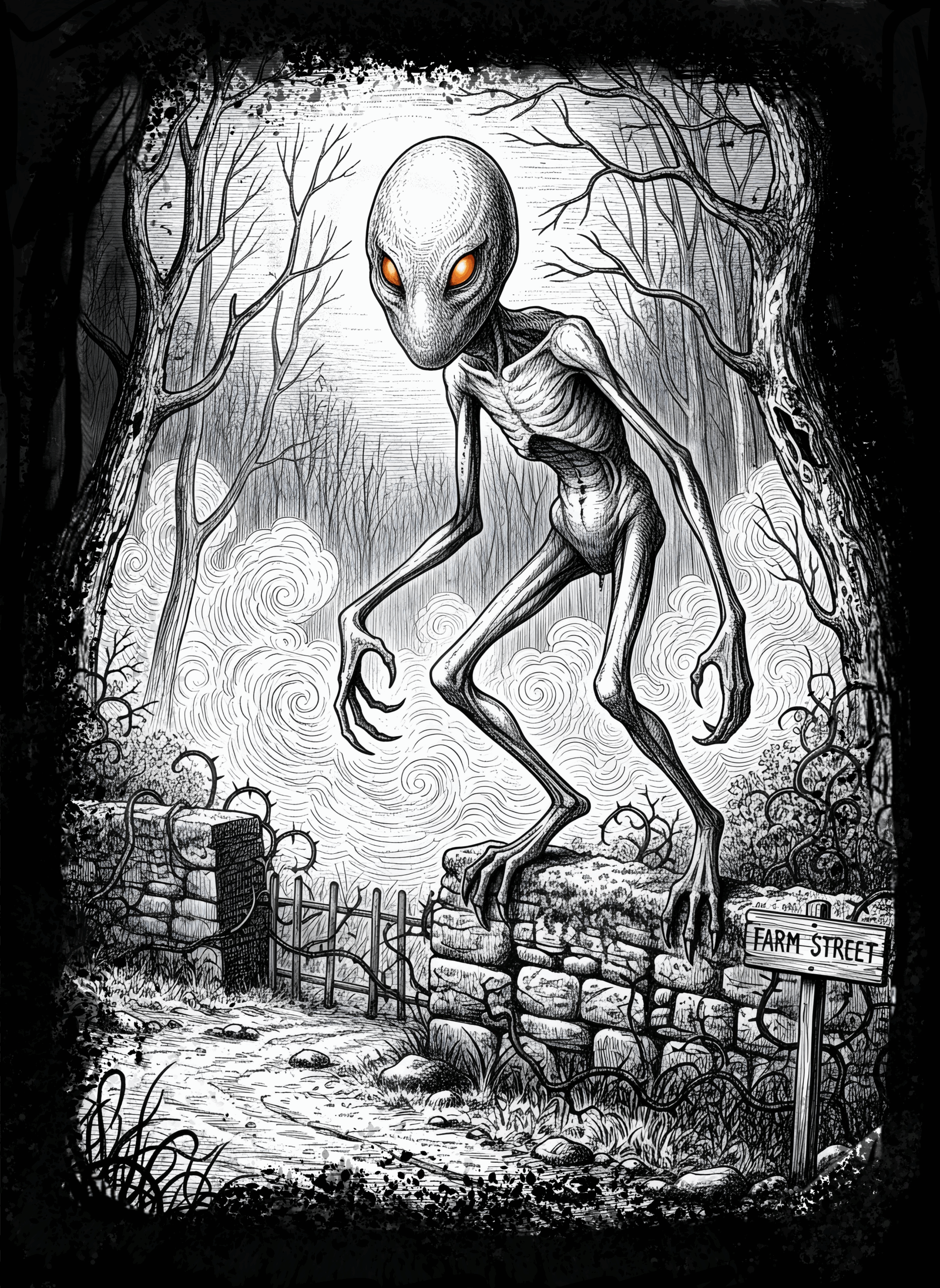
Dover Demon
Type: Cryptid / Humanoid
Region: Dover, Massachusetts, United States
Description: The Dover Demon is a small, humanoid cryptid first reported in April 1977. Standing about 3–4 feet tall, it is described as having a disproportionately large, bulbous head, glowing orange or green eyes, and a thin, spindly body with long limbs. Witnesses noted its skin appeared pale and hairless, almost chalky or peach-colored, with no visible mouth, nose, or ears. Unlike many other cryptids, it is not associated with fur or scales—its unsettling smoothness gives it an almost alien-like appearance.
Behavior: Sightings suggest the creature moves on all fours or in a crouched posture, scrambling with unnerving speed over walls, rocks, and terrain. The Dover Demon has never been observed to attack, but its silent presence and eerie gaze have left witnesses deeply unsettled. No vocalizations have been recorded. Its behavior appears elusive and defensive, vanishing quickly when spotted, suggesting a cautious, non-confrontational nature.
Cultural Significance: The Dover Demon became an instant mystery after multiple credible witnesses—including local teenagers—reported encounters within a span of just two nights in 1977. The creature’s bizarre features sparked debates in cryptozoology and UFO communities alike, with theories ranging from an alien being, to a misidentified animal, to a visitor from another dimension. Despite the brief wave of sightings, the Dover Demon has endured as a legendary Massachusetts cryptid, representing the strange and unexplained lurking even in suburban New England.
Flatwoods Monster

Flatwoods Monster
Type: Cryptid / Extraterrestrial Entity
Region: Flatwoods, Braxton County, West Virginia, USA
Description: The Flatwoods Monster, also known as the Braxton County Monster, is a bizarre and towering figure reportedly encountered by a group of locals after a fiery object streaked across the sky and crash-landed in the hills of Flatwoods, West Virginia. Witnesses described a floating humanoid figure with a red, glowing spade-shaped head, large eyes, and a body draped in what looked like a dark metallic or mechanical robe. The creature emitted a pungent, sulfuric odor and hissed or screeched when approached.
Behavior: Only seen once in its original 1952 encounter, the Flatwoods Monster has become a cryptid icon due to the sheer weirdness of its description. Witnesses reported physical symptoms after the sighting, including nausea, throat irritation, and temporary paralysis—leading some to speculate about radiation or toxic exposure.
Cultural Significance: Often associated with UFO sightings and 1950s flying saucer panic, the Flatwoods Monster blends cryptid lore with early alien encounter mythology. It remains one of the most unique and theatrical creatures in cryptozoology. The town of Flatwoods now celebrates the monster with themed events, statues, and even a roadside museum. Despite only one main sighting, the Flatwoods Monster has appeared in video games (Fallout 76), toys, and comics—earning it cult status among cryptid lore.
Grafton Monster
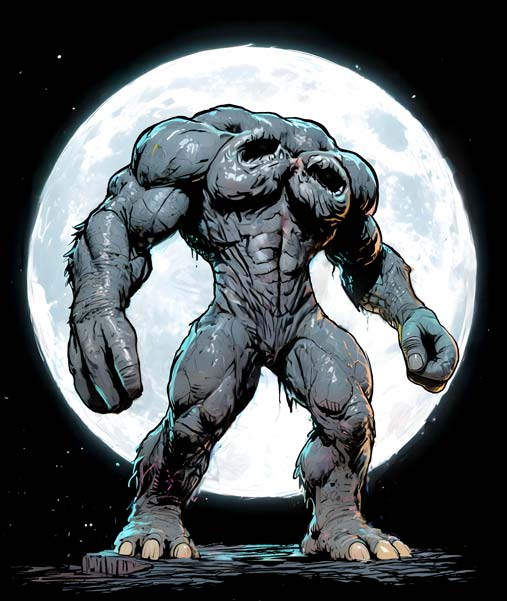
Grafton Monster
Type: Cryptid / Terrestrial Humanoid Entity
Region: Grafton, West Virginia, USA
Description: The Grafton Monster is a pale-skinned humanoid standing approximately 7–9 feet tall, described as muscular yet hairless, with smooth flesh that looks almost rubbery. Its most haunting feature: a face or head that appears sunken into its shoulders, giving an eerie, headless illusion. Despite its size, it moves in eerie silence and sometimes seems to glow faintly in foggy or overcast conditions. One key feature is the labored, wheezing breath that can sometimes be heard before the creature is seen—an eerie rasp echoing through the fog like a broken bellows.
Behavior: Elusive and silent, the creature avoids human contact and vanishes before it can be approached. There are no reports of attacks—just stunned witnesses left questioning what they saw.
Cultural Significance: First thrust into local legend by a 1964 encounter reported by journalist Robert Cockrell, the Grafton Monster has since become entrenched in West Virginia lore. Inspired countless monster-hunting parties, ghost hunts, and cryptid enthusiasts visiting Grafton hoping for a glimpse. Many witnesses reported seeing the creature in thick fog or during thunderstorms, leading some to believe it might be unaffected by—or even drawn to—odd atmospheric conditions. Others theorize it’s an interdimensional visitor, never leaving tracks or physical evidence.
Jersey Devil
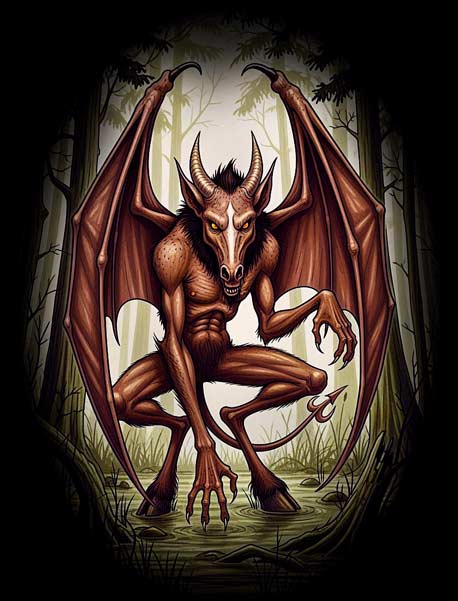
Jersey Devil
Type: Cryptid / Winged Chimera
Region: Pine Barrens, New Jersey, USA
Description: The Jersey Devil is a legendary cryptid said to haunt the dense, eerie Pine Barrens of New Jersey. Described as a grotesque hybrid with the head of a goat, leathery wings, clawed hands, hooved feet, and a serpent-like tail, it reportedly emits blood-curdling screeches that echo through the trees. According to folklore, the creature was the cursed 13th child of a woman named Mother Leeds, transformed into a monster and doomed to haunt the region forever.
Behavior: Nocturnal and notoriously elusive, the Jersey Devil is often spotted gliding silently between the pines or crossing rural roads in the dead of night. It’s said to kill livestock, terrify travelers, and vanish before it can be captured or recorded. Despite hundreds of alleged sightings, no physical evidence has ever been found.
Cultural Significance: The Jersey Devil is New Jersey’s most famous monster and has become a state icon, featured in newspapers, TV shows, and even sports mascots (Go New Jersey Devils!). It remains a powerful local legend with roots in early colonial superstition and ongoing folklore. In 1909, a wave of mass sightings and newspaper reports caused widespread panic across the Delaware Valley—some schools even closed, and hunting parties were formed to capture the creature.
Loch Ness Monster
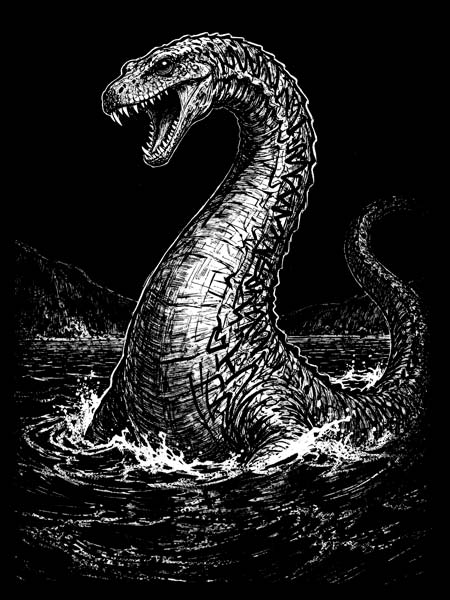
Loch Ness Monster
Type: Cryptid / Aquatic Entity
Region: Loch Ness, Scottish Highlands, Scotland
Description: The Loch Ness Monster, often called “Nessie,” is described as a massive aquatic creature with a long neck, small head, and large humps rising above the surface. Sightings suggest a length of 20–40 feet, with comparisons often made to a prehistoric plesiosaur or an enormous serpent. The loch’s deep, murky waters make the creature’s full appearance difficult to confirm.
Behavior: Elusive and rarely seen, Nessie is said to surface briefly before vanishing into the depths. Sightings often include ripples, wakes, or large shapes moving beneath the water. Some reports describe it as curious yet reclusive, appearing at a distance or during moments of calm on the loch.
Cultural Significance: Rooted in centuries-old Scottish folklore and propelled into global fame by modern sightings in the 1930s, the Loch Ness Monster is one of the most enduring cryptids in the world. Nessie has become a symbol of mystery, tourism, and imagination, solidifying its place as the Queen of aquatic legends.
Mantis Man
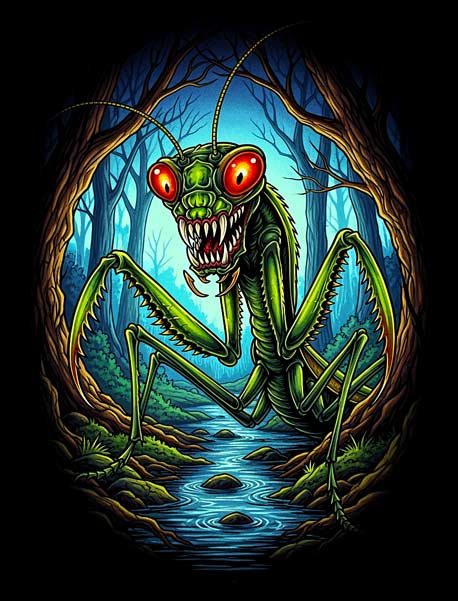
Mantis Man
Type: Cryptid / Insectoid Humanoid
Region: Hackettstown, New Jersey, USA (Musconetcong River area)
Description: The Mantis Man is a little-known but eerie cryptid reported near the banks of the Musconetcong River in New Jersey. Witnesses describe it as a 6-7 foot tall, insect-like creature with a humanoid shape, spindly limbs, and the distinctive triangular head and folded arms of a praying mantis. It is often reported as semi-transparent or shimmering, as if partially cloaked or phasing between dimensions.
Behavior: Typically seen during the day and near water, Mantis Man is not known to be aggressive but is often spotted briefly before vanishing. Witnesses describe a sense of overwhelming unease or mental fog during encounters. Some speculate it may be interdimensional, due to its shimmering or translucent appearance and sudden disappearances.
Cultural Significance: Mantis Man has gained a cult following online. It has been compared to alien greys or insectoid extraterrestrials and is sometimes grouped with modern paranormal entities like the Rake or Slenderman in contemporary cryptid lore. Some cryptid enthusiasts believe Mantis Man could be linked to meditative or psychic states, with speculation that sightings may involve temporary perception of beings not usually visible in normal consciousness.
Mothman
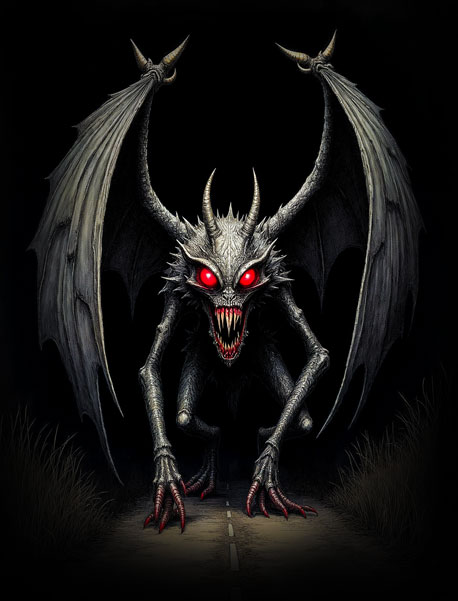
Mothman
Type: Cryptid / Winged Humanoid
Region: Point Pleasant, West Virginia, USA
Description: The Mothman is a mysterious winged creature said to haunt the skies around Point Pleasant, West Virginia. Witnesses describe it as a tall, dark, man-like figure with massive wings and glowing red eyes that pierce the night. Though it rarely speaks (or screeches), its presence is often accompanied by a deep sense of dread and strange electromagnetic disturbances.
Behavior: Reportedly silent in flight, the Mothman can hover without flapping its wings and is known to chase vehicles, perch on buildings, and vanish without a trace. Some believe it to be a harbinger of disaster, as sightings peaked shortly before the tragic 1967 Silver Bridge collapse.
Cultural Significance: Mothman has become a central figure in American cryptid lore, spawning books, documentaries, and even a 2002 Hollywood film. Point Pleasant now celebrates the creature annually with a Mothman Festival and features a dedicated museum and a towering metal statue in its honor.
Pope Lick Monster
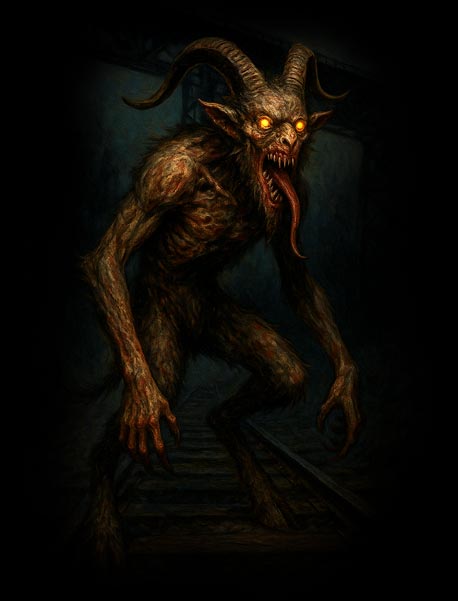
Pope Lick Monster
Type: Cryptid / Human-Goat Hybrid
Region: Pope Lick Creek, Louisville, Kentucky, USA
Description: The Pope Lick Monster is a legendary creature said to haunt the trestle bridge over Pope Lick Creek in Louisville, Kentucky. Often described as a satyr-like being with the lower body of a goat, a humanoid upper body, and a horned, grotesque face, it strikes a chilling silhouette. Some accounts describe it as decaying or ghostly, while others emphasize its strong animalistic features.
Behavior: The creature is notoriously associated with the railroad trestle where many of its alleged sightings occur. Urban legend claims the Pope Lick Monster uses hypnosis, mimicry, or telepathy to lure victims—especially thrill-seeking teens—onto the bridge, where they are struck by passing trains or fall to their deaths. However, no verified attacks have ever been recorded, and real-life tragedies associated with the site are often due to the dangerous location rather than the creature itself.
Cultural Significance: The Pope Lick Monster has become one of Kentucky’s most infamous urban legends. It blends aspects of American folklore, goatman myths, and cautionary tales, especially aimed at discouraging trespassing on dangerous structures. It has inspired documentaries, books, horror stories, and even local music and art projects. The eerie fusion of supernatural powers and tragic history has embedded its place in regional cryptid lore.
Skinwalker
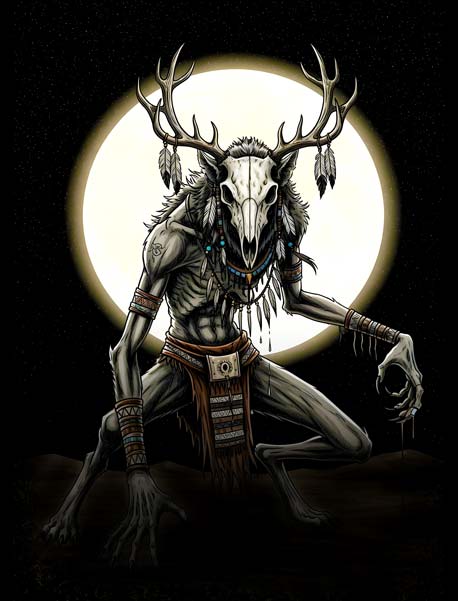
Skinwalker
Type: Paranormal Entity / Shapeshifter
Region: Southwestern United States, especially Navajo Nation lands in Arizona, Utah, and New Mexico
Description: A skinwalker is a type of shapeshifting witch or warlock in Navajo folklore. They are believed to be able to transform into animals, possess them, or mimic humans and animals. Skinwalkers are typically associated with malevolent magic and are feared for their ability to harm others. The term “skinwalker” specifically refers to the Navajo belief, though similar shapeshifting creatures exist in other indigenous cultures. Their true form is often described as a twisted, humanoid figure with animalistic features—fur-covered limbs, glowing eyes, and an aura of malevolent intent. Some witnesses report seeing creatures mid-shift, with contorted joints, partial animal traits, or disfigured human faces stretched into something unnatural.
Behavior: They are known for causing harm, fear, and using dark magic to terrorize people. Their behavior includes mimicking voices, causing strange noises, and manipulating others through curses and spells. Known for deception and mimicry. They possess supernatural speed, mimicry (imitating voices), and the ability to control minds. Navajo people often avoid speaking about skinwalkers, as they believe it can attract them. They can grow to be quite large, with some stories placing them at around 9 to 10 feet tall. Skinwalkers are said to appear as familiar animals, or even knock on windows and doors to lure victims outside. They’re often linked to dark rituals, forbidden magic, and acts of spiritual betrayal. Locals warn never to speak their true name, as doing so can draw their attention.
Cultural Significance: The legend of the Skinwalker is deeply sacred and feared within Navajo culture. It is a subject often avoided in conversation, even today. Modern sightings—especially around the infamous Skinwalker Ranch in Utah—have given rise to widespread interest in the phenomenon, blending ancient lore with conspiracy theories, paranormal investigations, and fringe science.
Snallygaster
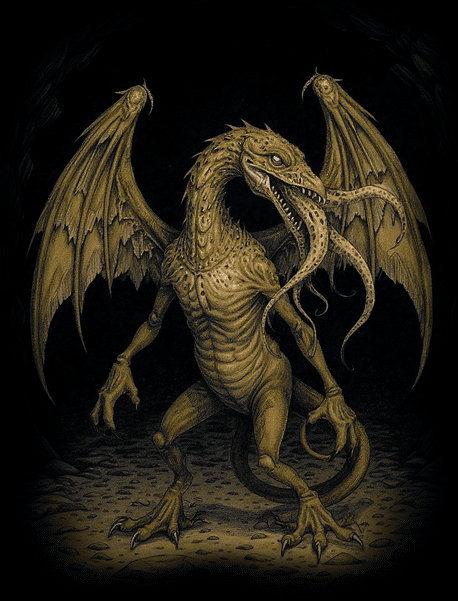
Snallygaster
Type: Cryptid / Dragon-like Beast
Region: Maryland, Pennsylvania, and the Mid-Atlantic USA
Description: The Snallygaster is a bizarre, dragon-like creature said to inhabit the hills and forests of Maryland and surrounding Mid-Atlantic states. Early German settlers described it as a terrifying beast with a long, metallic beak lined with razor-sharp teeth, a scaly or feathered body, massive wings, and sometimes even tentacles. Legend holds that the Snallygaster swoops down to snatch livestock—and occasionally unsuspecting humans.
Behavior: Known for its bloodthirsty nature, the Snallygaster is said to drain the blood of its victims with its sharp beak before carrying them off. It’s described as a powerful flyer capable of terrorizing entire communities, and sightings were once so common that newspapers in the 1800s ran stories about it. Some accounts suggest it was hunted using firearms and even cannons during early encounters.
Cultural Significance:
The Snallygaster has become a symbol of Maryland folklore and is celebrated for its weird, over-the-top mythology. It blends early European dragon myths with Appalachian storytelling, and its legend once grew so large that a U.S. President (Theodore Roosevelt) was rumored to have considered hunting it. Today, it’s honored at local festivals, and even a craft brewery, Flying Dog Brewery, features the Snallygaster as its mascot. According to local tales, the Snallygaster has a mortal enemy known as the Dwayyo, a wolf-like creature said to clash with the winged beast in the forests of Maryland.
Tsiatko
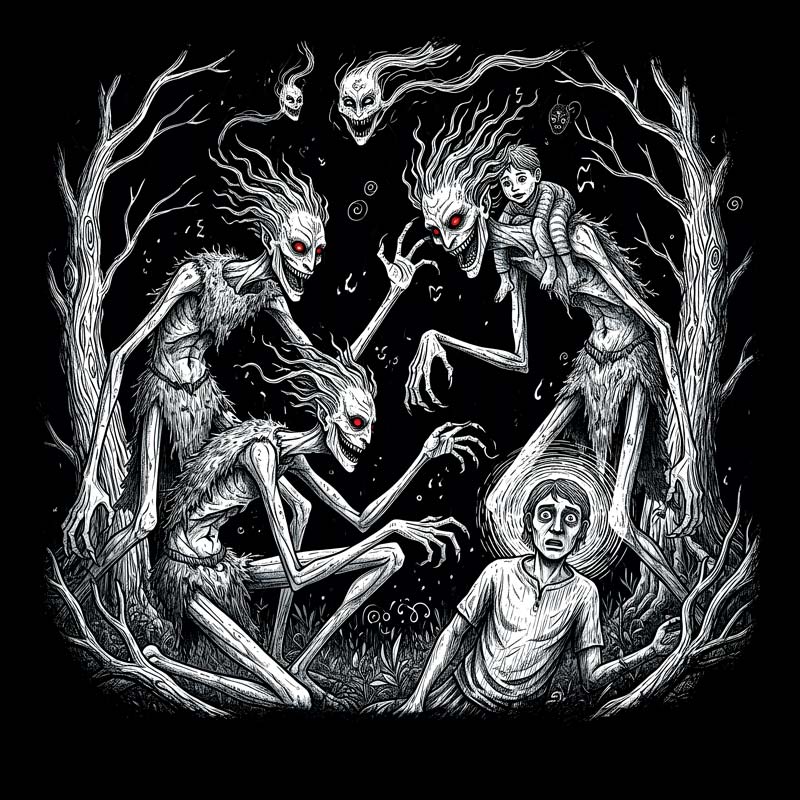
Tsiatko
Type: Paranormal Entity / Forest Spirit
Region: Pacific Northwest (Washington, Oregon, British Columbia), Northern California, and the Cascades, Rocky Mountain Region
Description: The Tsiatko or Stick Indians are mysterious, malevolent forest entities found in the oral traditions of several Indigenous peoples of the Pacific Northwest, including the Salish, Spokane, and Nez Perce tribes. Rarely seen directly, but often described as small, sometimes as small as 18 inches tall, with some accounts describing them as being the size of an ordinary person. They are said to have long hair, wrinkled faces, and may wear deer skin, cloaked in darkness or foliage, often disfigured or faceless. Their name comes from the eerie sounds they produce—branches breaking, stick-clicking, tree-knocking, and high-pitched laughter echoing through the woods at night. Unlike many cryptids, Stick Indians are considered spirit beings, not animals, and are often treated with extreme caution and reverence in Native stories. Some tribes refuse to speak of them directly—even today.
Behavior: They are known for their mischievous and sometimes malevolent behavior. They might lead people astray with whistling or other sounds, steal children, or even harm people. They are also depicted as being vengeful and quick to retaliate against those who disrespect them. Tsiatko have powers to paralyze, hypnotize, or cause insanity in hapless humans, while in others, they merely lead astray by making eerie sounds of whistling or laughter in the woods at night. Different tribes have their own names and specific legends about these beings, but they are generally seen as a type of “little people” who possess supernatural abilities.
Wendigo
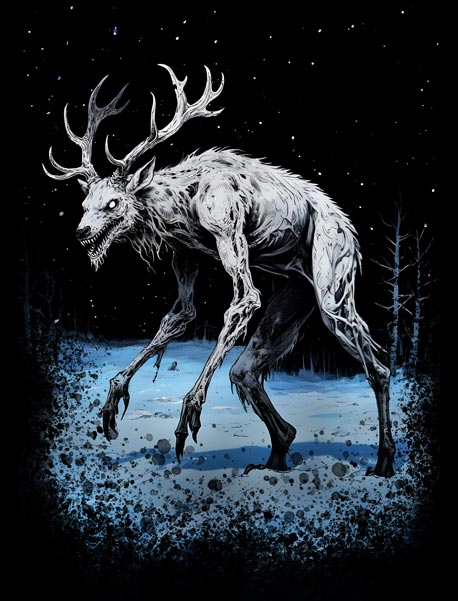
Wendigo
Type: Cryptid / Spirit Entity
Region: Northern USA and Canada (Great Lakes, Algonquian territories)
Description: The Wendigo is a terrifying, cannibalistic creature rooted in the folklore of several Indigenous peoples of the northern forests, particularly the Algonquian-speaking nations. Said to embody greed, gluttony, and unending hunger, the Wendigo is often described as a gaunt, towering figure with corpse-like skin, sunken or glowing eyes, and an insatiable craving for human flesh. Some versions portray it with animalistic features such as sharp claws, fangs, or deer-like antlers.
Behavior: Wendigos are said to stalk forests during harsh winters, preying on lost travelers or isolated camps. In many traditions, a human who engages in cannibalism—or even excessive selfishness—may become a Wendigo, cursed to wander endlessly, hollow with hunger. They are depicted as relentless, intelligent, and nearly impossible to kill through conventional means. Growing larger and more powerful with every ounce of flesh they consume.
Cultural Significance: The Wendigo serves as both a literal and symbolic warning in Indigenous storytelling—representing the dangers of greed, isolation, and moral corruption. It is deeply embedded in Ojibwe, Cree, and Innu oral traditions and is considered a spiritual entity as much as a physical one. In modern media, the Wendigo has been reimagined in horror films, video games, and cryptid lore, often blending myth with monster. There is a psychiatric disorder named Wendigo psychosis—a controversial and rare diagnosis in which individuals develop an intense craving for human flesh and fear turning into a Wendigo.
Wharty
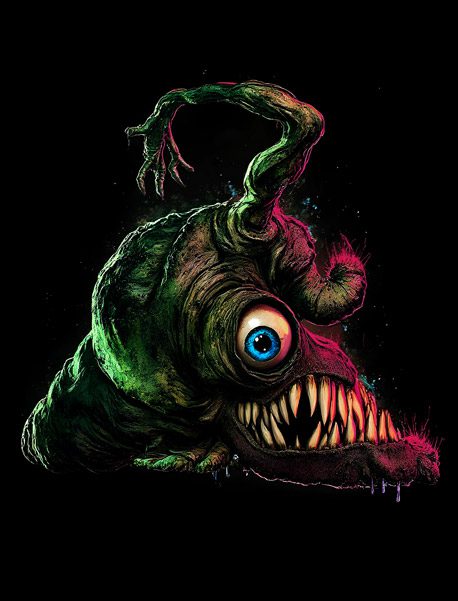
Wharty Monster
Type: Creature Creation / Folkloric Oddity
Region: Creeks and streams of the Adirondack Mountains of NY, USA
Description: The Wharty Monster is a grotesque yet oddly charming creature said to dwell in the cold, clear waters of Adirondack mountain streams. Its disheveled appearance is infamous: a single bloodshot eye stares from its sagging face, its skin is covered with warts and sores, and a twisted, clawed hand sprouts from its head like a nightmarish crown. Despite its horrifying looks, the Wharty Monster is known to be harmless—some even claim it’s endearingly polite, with a croaky voice and an unsettling sense of humor.
Behavior: The Wharty Monster is shy but curious, often popping its grotesque head above the water to watch hikers or fishermen. It’s said to wave its hand as a greeting and sometimes attempts to shake hands albeit awkwardly. Witnesses report being simultaneously repulsed and inexplicably charmed, describing the creature as “like meeting a melted toad with a personality.” Those who encounter it often claim to experience unusual streaks of good fortune—winning lotteries, finding lost items, or enjoying sudden creative inspiration.
Cultural Significance: Local Adirondack legends suggest that the Wharty Monster brings luck to anyone who can withstand its appearance and treat it with kindness. It’s considered a kind of grotesque guardian spirit of the streams, known to rescue lost hikers or lead animals to fresh water. Folklore warns that mocking its appearance may cause a reversal of fortune, as the creature is sensitive about its appearance. The Wharty Monster is rumored to enjoy singing (badly) at night, its raspy voice echoing across mountain valleys. Some locals leave offerings of soap or scented herbs near streams, believing the creature loves the smell but hates washing. Despite its foul stench, it is said to smell faintly of pine sap when happy.
Yowie
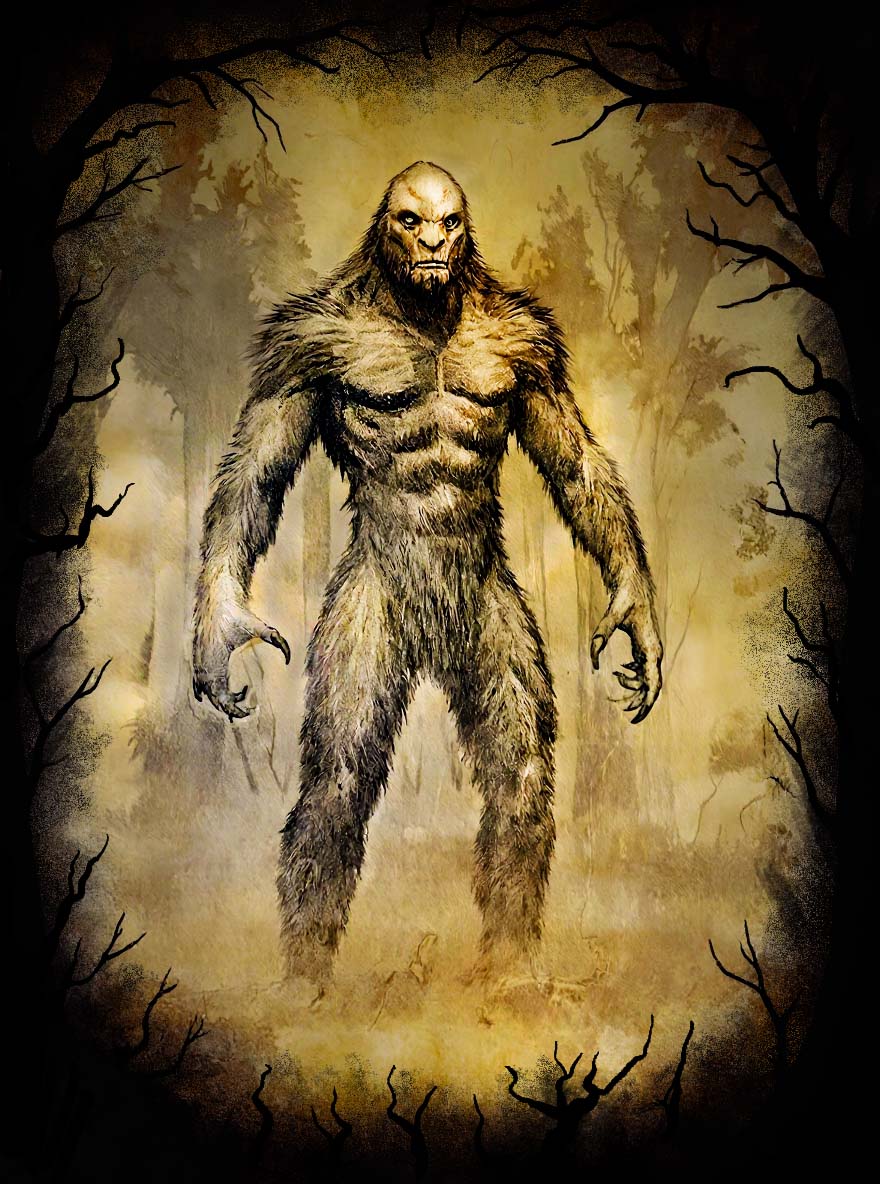
Yowie
Type: Cryptid / Hominid
Region: Australia (Eastern Australia, particularly Queensland and New South Wales)
Description: The Yowie is Australia’s most famous cryptid—an elusive, ape-like humanoid said to roam the dense bushlands and mountain ranges of the eastern continent. Descriptions vary, but most accounts describe a towering, muscular creature covered in reddish-brown or dark hair, with a large head, deep-set eyes, and a flat, wide nose. Some witnesses report sharp claws and a powerful odor, similar to rotting vegetation or sulfur.
Behavior: Yowie sightings range from brief glimpses to chilling close encounters. The creature is usually shy, avoiding human contact, though some stories claim it emits guttural howls, screams, or even mimics human speech. It’s typically seen alone, often at night, and leaves behind large footprints. Despite many sightings, it vanishes quickly—leaving behind confusion, fear, and a lingering sense of awe.
Cultural Significance: The Yowie has deep roots in Aboriginal mythology, where it is sometimes described as a spirit or guardian of the land, often called the Yahoo, Putikan, or other regional names. European settlers adopted the term “Yowie” in the 19th century, and the creature has since become a fixture in Australian folklore, comparable to Bigfoot in North America. It features in local legends, documentaries, children’s books, and even chocolate bars. In the 1990s, the Yowie became a marketing icon in Australia when Cadbury launched a line of Yowie chocolate eggs—each containing a collectible creature figure based on real and mythical animals from the outback.
